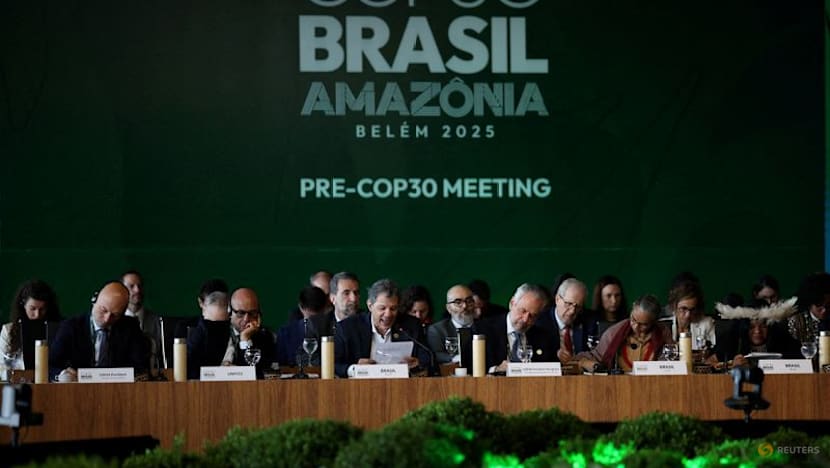COP30: 5 hot topics to watch as Brazil hosts global climate talks
Money, climate commitments and the role of America are set to feature highly during the two-week long climate talks starting on Nov 10 in the Amazon rainforest.

This Aug 10, 2025 drone image shows the Amazon rainforest and the city of Belem in Para state, Brazil, ahead of COP30. (Photo: Reuters/Anderson Coelho)

This audio is generated by an AI tool.
BANGKOK: The Amazon rainforest will play host this month to crucial discussions about the future of the planet, as tens of thousands of politicians, policymakers, lobbyists and industry figures descend on Brazil for COP30.
COP stands for the Conference of the Parties and is an annual summit attended by countries that are signatories of the United Nations Framework Convention on Climate Change (UNFCCC).
The conference is scheduled to run from Nov 10 to 21, though heads of state will meet earlier from Nov 6-7.
COP30 is being held in the remote port city of Belem, chosen for its close proximity to the Amazon, a symbolic move to bring power decision makers to the front lines of one of the Earth’s biggest carbon-absorbing and biodiversity-rich ecosystems.
This 30th edition of UN talks comes 10 years on from the Paris Agreement, a landmark multilateral deal that set the direction and rules for negotiations around climate change in the years since.
Observers say the stakes will be high; as COP30 faces renewed pressure to deliver new national climate plans, while having to test a fresh finance deal amid existential questions hanging over the viability of the entire UN process.
Countries will need to make major decisions about whether the lofty goals of the Paris Agreement are still workable in today’s fractured but fast-heating world, amid a backdrop of global tensions and where one of the biggest polluters - the United States - has withdrawn from the agreement.
Beyond politics, planetary concerns have never been more serious.
The world is on track to see an increase of 2.6 degrees Celsius this century if current emissions reduction pledges are fully implemented, according to a report released in October by Climate Central, an independent group of scientists and communicators.
Such heating would result in a dangerously hot planet and significantly increase the intensity of extreme events.
But collectively, reducing emissions has been slow going. Carbon dioxide levels in the atmosphere reached record-high levels in 2024, according to the US National Oceanic and Atmospheric Administration, also leading to more heating and dangerous weather.
Major climate-intensified weather events in 2025, including heatwaves, torrential rainfall, tropical cyclones and glacial break-offs have thrust more urgency onto what is expected to be yet another round of tense, charged negotiations over the next two weeks.
Here are five key things to watch as the global attention turns to Brazil.

1. A make-or-break year for national climate plans
By COP30, countries are meant to have presented their new climate promises for the next decade, up to 2035.
These progress commitments called Nationally Determined Contributions (NDCs) are key markers to ensure governments remain ambitious and that the goals of the Paris Agreement, especially limiting global warming to well below 2 degrees Celsius, are kept within reach.
This is also a decade half-way point; 2030 is seen as a critical juncture to have implemented a strong climate agenda.
While the NDCs are not meant to be central items on the COP agenda - they were meant to be submitted by February this year, well in advance of the talks - many parties have indicated that the summit itself is crucial to determining their own goals going forward.
Most governments have fallen behind in submitting their goals. Two months out from COP30, only 47 of the 195 parties had finalised their 2035 ambitions.
Malaysia and Indonesia were the latest countries in Southeast Asia to update their NDCs - barely a fortnight out from the summit - following Singapore, Cambodia and Brunei as others in the region to do so.
Some of the big players are moving, however. In September, Chinese President Xi Jinping announced economy-wide reduction targets covering all sectors for the first time.
While the commitment is modest - a 7-10 per cent drop from peak levels by 2035 - it is notable for being the first time that China has set an absolute reduction target. Xi has previously committed the country to carbon neutrality by 2060.
This means China is promising to cut its total emissions, not just slow their growth, a significant shift in approach for the world’s largest emitter.
The European Union has failed to submit its goals, but has made a statement of intent to do so.
New agency Reuters quoted a White House official as saying on Oct 31 that Washington will not send any high-level officials to COP30.
The official added that US President Donald Trump has already made his administration's views on multilateral climate action clear in his speech at the UN General Assembly in September, where he called climate change the world's "greatest con job", among other things.
Trump had previously officially withdrawn the country from the Paris Agreement in January, a move that will take one year to finalise.
The US will join Iran, Libya and Yemen as the only nations not party to the agreement.

2. America the bellwether for fractured geopolitics
The likely absence of key American policymakers in Brazil, and the country’s retreat from constructive multilateral engagement, could cause ripple effects across a broader spectrum of nations.
As the world’s second largest polluter and largest economy, the US has much influence over the global climate agenda and all signs point to its moves jeopardising action globally.
Previous decarbonisation commitments made by the Biden Administration last year are not likely to be honoured by the current regime, and under Trump, Washington’s stance has hardened against contributing to international climate finance and other multilateral mechanisms like the Loss and Damage Fund.
Trump took aim at those advocating for tackling climate change during his address to the UN General Assembly in September.
“This climate change, it’s the greatest con job ever perpetrated on the world, in my opinion,” he said.
“All of these predictions made by the United Nations and many others, often for bad reasons, were wrong. They were made by stupid people that have cost their countries fortunes and given those same countries no chance for success. If you don’t get away from this green scam, your country is going to fail.”
He has also wound back many aspects of Biden’s landmark industrial policy - the Inflation Reduction Act - which directed hundreds of millions of dollars in subsidies and tax credits at a whole host of domestic clean industries.
Some experts have expressed concerns about a certain amount of contagion filtering through to other governments, which may be less inclined to make good on ambitious climate goals or calls to make hefty financial contributions.
But a contrary view is that it could clear the way for motivated parties to make progress without the US being a roadblock to the many agreements and goals being negotiated.

3. What follows COP29’s new money goal?
COP29 in Baku unlocked a new global financial objective of at least US$300 billion a year by 2035 and a broader aim to mobilise US$1.3 trillion from all sources.
These are funds intended to be provided by developed nations as financial support to developing countries under an agreement called the New Collective Quantified Goal.
It was far below the amount that many states in the Global South - a loose collective term for less industrialised, lower-income nations - had been calling for as they increasingly are afflicted with compounding climate costs.
Current estimates for climate financing for loss and damage alone could be in the range of US$290-580 billion a year by 2030, a figure that exponentially grows decade by decade.
Realising these funds and seeing them start to be pushed through the pipeline is expected to be a hot debate topic in Belem. There are multiple complexities and sticking points, such as how the money is counted and clear roadmaps for delivery.
Developing nations have expressed their concerns that recycled pledges or creative accounting might reduce the money they are meant to receive.
Simon Stiell, the UN Climate Change Executive Secretary, said the lack of finance was the “number one constraint” holding back climate adaptation.
“Let's be very clear: climate finance is not charity. It is vital for protecting every population and economy, and the global supply chains that every nation depends on for low-inflationary growth, and food and energy security,” he said at the launch of the National Adaptation Plans Progress Report on Oct 21.

4. The Amazon front and centre
"We decided to hold COP in Belem so that people can see what the Amazon really is,” Brazil’s president Luiz Inácio Lula da Silva said in a speech in August.
The government has gone to great lengths to put its precious rainforest ecosystem as the centrepiece of these talks, defying logistical headaches and criticisms of the potential exclusionary nature of holding a major summit in a small regional city ill-equipped to handle the 50,000-odd expected attendees.
It has said it wants to showcase the needs of the Amazon and the people that rely on it, meaning issues related to forest-based economies, Indigenous leadership and financing options for such communities may have more focus than in previous COPs.
Saving tropical forests will once again be a key global agenda, following the release of data from the University of Maryland that showed a record 6.7 million hectares of primary rainforest was lost in 2024, an area more than 90 times the size of Singapore.
During the hottest year on record, the major cause was fire, which contributed to the release of massive amounts of greenhouse gas emissions from these forest areas.
Brazil’s deforestation has dropped sharply under the current administration but the country remains the largest contributor to forest loss.

5. Carbon rules are set but now comes the real test
Article 6 of the Paris Agreement, which relates to the rules and frameworks for international carbon markets, had been a lingering issue before negotiators finally made key breakthroughs at COP29.
For nearly 10 years, there had been a lack of consensus on many of the technical aspects of the article.
COP30 will see a primary shift from rulemaking to its implementation.
Carbon trading and credits can be used by countries to meet emissions-reductions targets and make achieving those goals cheaper.
For example, major emitters could buy carbon credits - effectively the right to emit beyond their usual limits - from countries that have earned extra allowances through actions like restoring rainforests or protecting natural carbon sinks.
Most countries have indicated they intend to use such mechanisms to help achieve their NDCs.
Some of these exchanges are already taking shape through pilot programmes and regional or bilateral deals. Singapore is an active player in this space and has agreements in place with multiple other countries around the world.
Article 6.4 sets the stage for the first regulated global carbon market, overseen by the UN. At COP30, the final technical details will be negotiated before that market can open.
















